Murdoch University Server: TCO Analysis for ICT171 Course
VerifiedAdded on 2023/01/18
|8
|1715
|79
Report
AI Summary
This report presents a total cost of ownership (TCO) analysis for a proposed centralized server at Murdoch University, designed to support network simulation software like Cisco Packet Tracer and EVE-NG. The analysis considers the limitations of the current desktop-based approach, addressing issues such as students' computer hardware requirements and technical support demands. The report proposes a Lenovo ThinkSystem SR860 server with specific hardware specifications, including CPU cores, RAM, and storage, along with a UPS for power backup. It details the costs associated with hardware and software purchases, including VMware's vSphere operating system. Furthermore, the report provides a detailed cost breakdown over a five-year project lifetime, including hardware, software, support, power, and cooling expenses. The conclusion emphasizes the financial investment and operational expenditures required to run the server, highlighting the importance of evaluating costs, benefits, and service quality. The report also acknowledges the use of estimated costs based on available information from manufacturers like Lenovo, and emphasizes that these are estimations based on data available up to 2019.
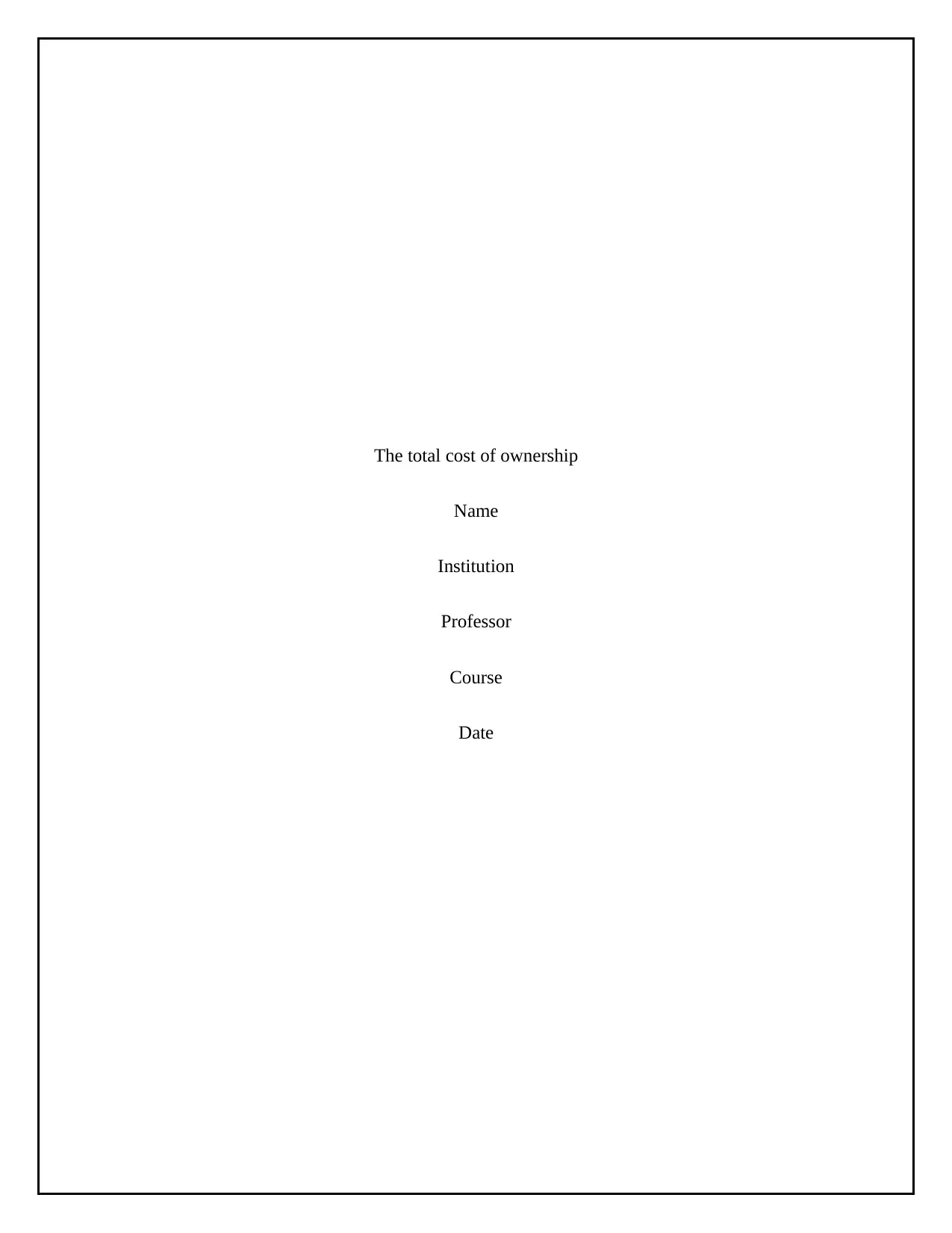
The total cost of ownership
Name
Institution
Professor
Course
Date
Name
Institution
Professor
Course
Date
Paraphrase This Document
Need a fresh take? Get an instant paraphrase of this document with our AI Paraphraser
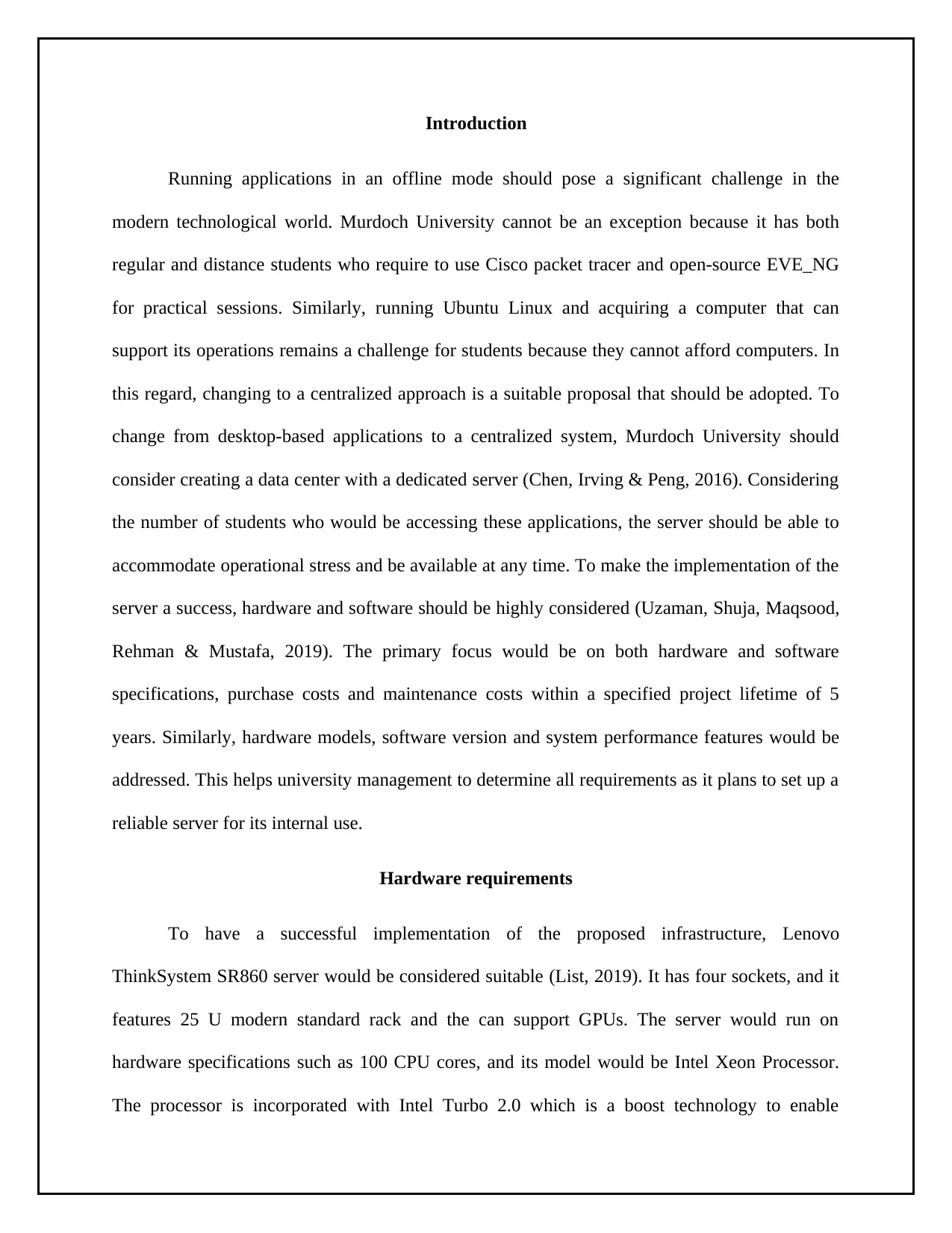
Introduction
Running applications in an offline mode should pose a significant challenge in the
modern technological world. Murdoch University cannot be an exception because it has both
regular and distance students who require to use Cisco packet tracer and open-source EVE_NG
for practical sessions. Similarly, running Ubuntu Linux and acquiring a computer that can
support its operations remains a challenge for students because they cannot afford computers. In
this regard, changing to a centralized approach is a suitable proposal that should be adopted. To
change from desktop-based applications to a centralized system, Murdoch University should
consider creating a data center with a dedicated server (Chen, Irving & Peng, 2016). Considering
the number of students who would be accessing these applications, the server should be able to
accommodate operational stress and be available at any time. To make the implementation of the
server a success, hardware and software should be highly considered (Uzaman, Shuja, Maqsood,
Rehman & Mustafa, 2019). The primary focus would be on both hardware and software
specifications, purchase costs and maintenance costs within a specified project lifetime of 5
years. Similarly, hardware models, software version and system performance features would be
addressed. This helps university management to determine all requirements as it plans to set up a
reliable server for its internal use.
Hardware requirements
To have a successful implementation of the proposed infrastructure, Lenovo
ThinkSystem SR860 server would be considered suitable (List, 2019). It has four sockets, and it
features 25 U modern standard rack and the can support GPUs. The server would run on
hardware specifications such as 100 CPU cores, and its model would be Intel Xeon Processor.
The processor is incorporated with Intel Turbo 2.0 which is a boost technology to enable
Running applications in an offline mode should pose a significant challenge in the
modern technological world. Murdoch University cannot be an exception because it has both
regular and distance students who require to use Cisco packet tracer and open-source EVE_NG
for practical sessions. Similarly, running Ubuntu Linux and acquiring a computer that can
support its operations remains a challenge for students because they cannot afford computers. In
this regard, changing to a centralized approach is a suitable proposal that should be adopted. To
change from desktop-based applications to a centralized system, Murdoch University should
consider creating a data center with a dedicated server (Chen, Irving & Peng, 2016). Considering
the number of students who would be accessing these applications, the server should be able to
accommodate operational stress and be available at any time. To make the implementation of the
server a success, hardware and software should be highly considered (Uzaman, Shuja, Maqsood,
Rehman & Mustafa, 2019). The primary focus would be on both hardware and software
specifications, purchase costs and maintenance costs within a specified project lifetime of 5
years. Similarly, hardware models, software version and system performance features would be
addressed. This helps university management to determine all requirements as it plans to set up a
reliable server for its internal use.
Hardware requirements
To have a successful implementation of the proposed infrastructure, Lenovo
ThinkSystem SR860 server would be considered suitable (List, 2019). It has four sockets, and it
features 25 U modern standard rack and the can support GPUs. The server would run on
hardware specifications such as 100 CPU cores, and its model would be Intel Xeon Processor.
The processor is incorporated with Intel Turbo 2.0 which is a boost technology to enable
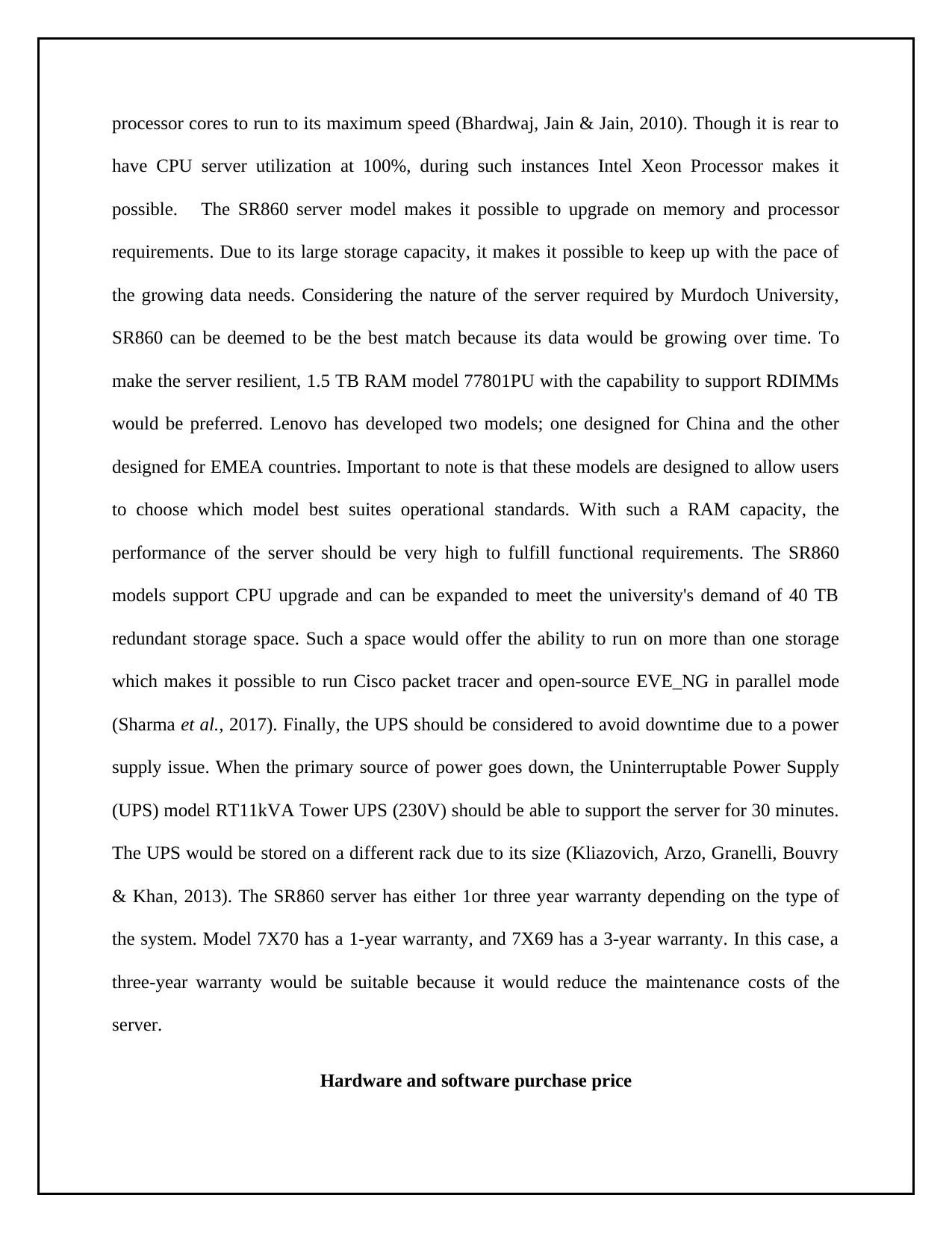
processor cores to run to its maximum speed (Bhardwaj, Jain & Jain, 2010). Though it is rear to
have CPU server utilization at 100%, during such instances Intel Xeon Processor makes it
possible. The SR860 server model makes it possible to upgrade on memory and processor
requirements. Due to its large storage capacity, it makes it possible to keep up with the pace of
the growing data needs. Considering the nature of the server required by Murdoch University,
SR860 can be deemed to be the best match because its data would be growing over time. To
make the server resilient, 1.5 TB RAM model 77801PU with the capability to support RDIMMs
would be preferred. Lenovo has developed two models; one designed for China and the other
designed for EMEA countries. Important to note is that these models are designed to allow users
to choose which model best suites operational standards. With such a RAM capacity, the
performance of the server should be very high to fulfill functional requirements. The SR860
models support CPU upgrade and can be expanded to meet the university's demand of 40 TB
redundant storage space. Such a space would offer the ability to run on more than one storage
which makes it possible to run Cisco packet tracer and open-source EVE_NG in parallel mode
(Sharma et al., 2017). Finally, the UPS should be considered to avoid downtime due to a power
supply issue. When the primary source of power goes down, the Uninterruptable Power Supply
(UPS) model RT11kVA Tower UPS (230V) should be able to support the server for 30 minutes.
The UPS would be stored on a different rack due to its size (Kliazovich, Arzo, Granelli, Bouvry
& Khan, 2013). The SR860 server has either 1or three year warranty depending on the type of
the system. Model 7X70 has a 1-year warranty, and 7X69 has a 3-year warranty. In this case, a
three-year warranty would be suitable because it would reduce the maintenance costs of the
server.
Hardware and software purchase price
have CPU server utilization at 100%, during such instances Intel Xeon Processor makes it
possible. The SR860 server model makes it possible to upgrade on memory and processor
requirements. Due to its large storage capacity, it makes it possible to keep up with the pace of
the growing data needs. Considering the nature of the server required by Murdoch University,
SR860 can be deemed to be the best match because its data would be growing over time. To
make the server resilient, 1.5 TB RAM model 77801PU with the capability to support RDIMMs
would be preferred. Lenovo has developed two models; one designed for China and the other
designed for EMEA countries. Important to note is that these models are designed to allow users
to choose which model best suites operational standards. With such a RAM capacity, the
performance of the server should be very high to fulfill functional requirements. The SR860
models support CPU upgrade and can be expanded to meet the university's demand of 40 TB
redundant storage space. Such a space would offer the ability to run on more than one storage
which makes it possible to run Cisco packet tracer and open-source EVE_NG in parallel mode
(Sharma et al., 2017). Finally, the UPS should be considered to avoid downtime due to a power
supply issue. When the primary source of power goes down, the Uninterruptable Power Supply
(UPS) model RT11kVA Tower UPS (230V) should be able to support the server for 30 minutes.
The UPS would be stored on a different rack due to its size (Kliazovich, Arzo, Granelli, Bouvry
& Khan, 2013). The SR860 server has either 1or three year warranty depending on the type of
the system. Model 7X70 has a 1-year warranty, and 7X69 has a 3-year warranty. In this case, a
three-year warranty would be suitable because it would reduce the maintenance costs of the
server.
Hardware and software purchase price
⊘ This is a preview!⊘
Do you want full access?
Subscribe today to unlock all pages.

Trusted by 1+ million students worldwide
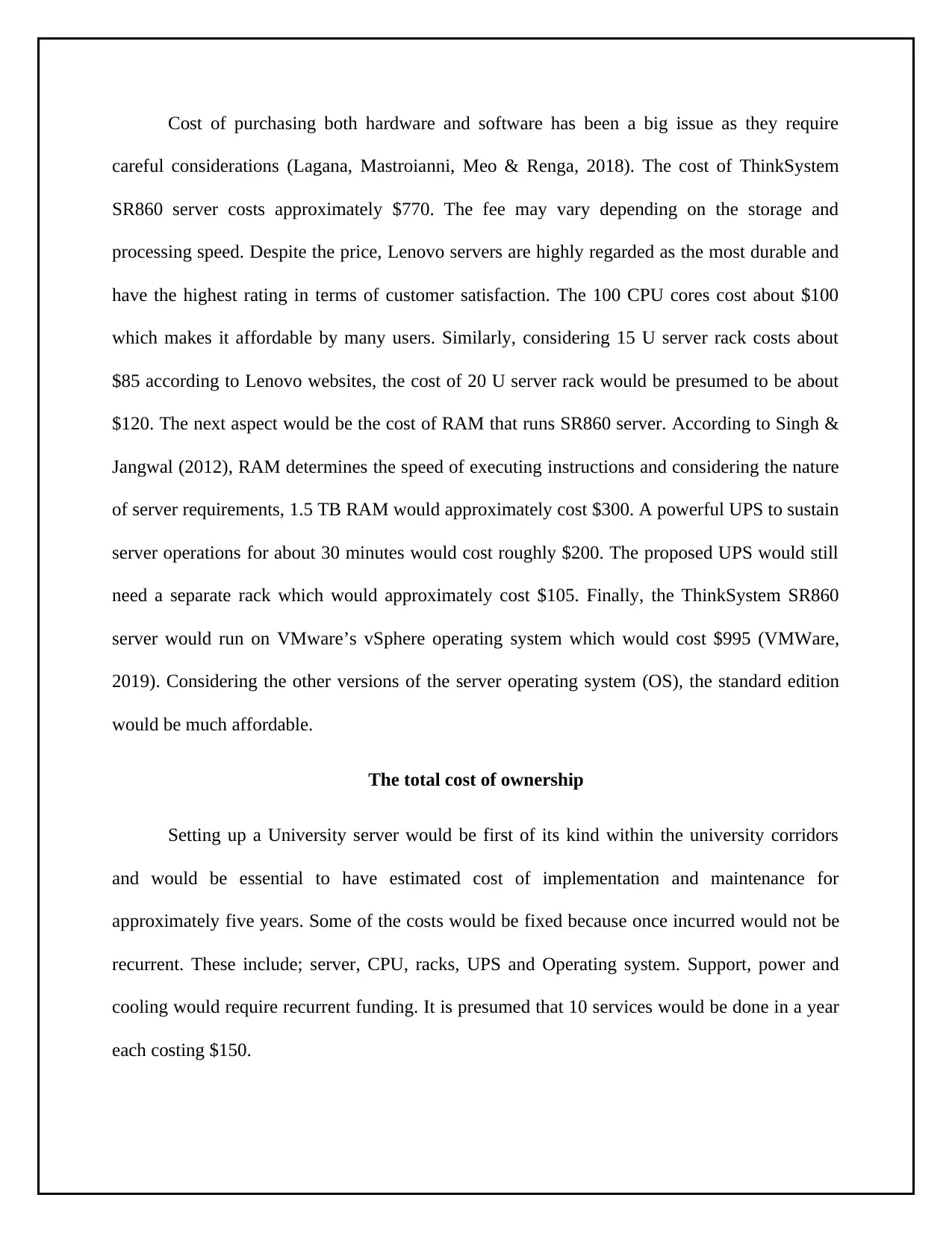
Cost of purchasing both hardware and software has been a big issue as they require
careful considerations (Lagana, Mastroianni, Meo & Renga, 2018). The cost of ThinkSystem
SR860 server costs approximately $770. The fee may vary depending on the storage and
processing speed. Despite the price, Lenovo servers are highly regarded as the most durable and
have the highest rating in terms of customer satisfaction. The 100 CPU cores cost about $100
which makes it affordable by many users. Similarly, considering 15 U server rack costs about
$85 according to Lenovo websites, the cost of 20 U server rack would be presumed to be about
$120. The next aspect would be the cost of RAM that runs SR860 server. According to Singh &
Jangwal (2012), RAM determines the speed of executing instructions and considering the nature
of server requirements, 1.5 TB RAM would approximately cost $300. A powerful UPS to sustain
server operations for about 30 minutes would cost roughly $200. The proposed UPS would still
need a separate rack which would approximately cost $105. Finally, the ThinkSystem SR860
server would run on VMware’s vSphere operating system which would cost $995 (VMWare,
2019). Considering the other versions of the server operating system (OS), the standard edition
would be much affordable.
The total cost of ownership
Setting up a University server would be first of its kind within the university corridors
and would be essential to have estimated cost of implementation and maintenance for
approximately five years. Some of the costs would be fixed because once incurred would not be
recurrent. These include; server, CPU, racks, UPS and Operating system. Support, power and
cooling would require recurrent funding. It is presumed that 10 services would be done in a year
each costing $150.
careful considerations (Lagana, Mastroianni, Meo & Renga, 2018). The cost of ThinkSystem
SR860 server costs approximately $770. The fee may vary depending on the storage and
processing speed. Despite the price, Lenovo servers are highly regarded as the most durable and
have the highest rating in terms of customer satisfaction. The 100 CPU cores cost about $100
which makes it affordable by many users. Similarly, considering 15 U server rack costs about
$85 according to Lenovo websites, the cost of 20 U server rack would be presumed to be about
$120. The next aspect would be the cost of RAM that runs SR860 server. According to Singh &
Jangwal (2012), RAM determines the speed of executing instructions and considering the nature
of server requirements, 1.5 TB RAM would approximately cost $300. A powerful UPS to sustain
server operations for about 30 minutes would cost roughly $200. The proposed UPS would still
need a separate rack which would approximately cost $105. Finally, the ThinkSystem SR860
server would run on VMware’s vSphere operating system which would cost $995 (VMWare,
2019). Considering the other versions of the server operating system (OS), the standard edition
would be much affordable.
The total cost of ownership
Setting up a University server would be first of its kind within the university corridors
and would be essential to have estimated cost of implementation and maintenance for
approximately five years. Some of the costs would be fixed because once incurred would not be
recurrent. These include; server, CPU, racks, UPS and Operating system. Support, power and
cooling would require recurrent funding. It is presumed that 10 services would be done in a year
each costing $150.
Paraphrase This Document
Need a fresh take? Get an instant paraphrase of this document with our AI Paraphraser
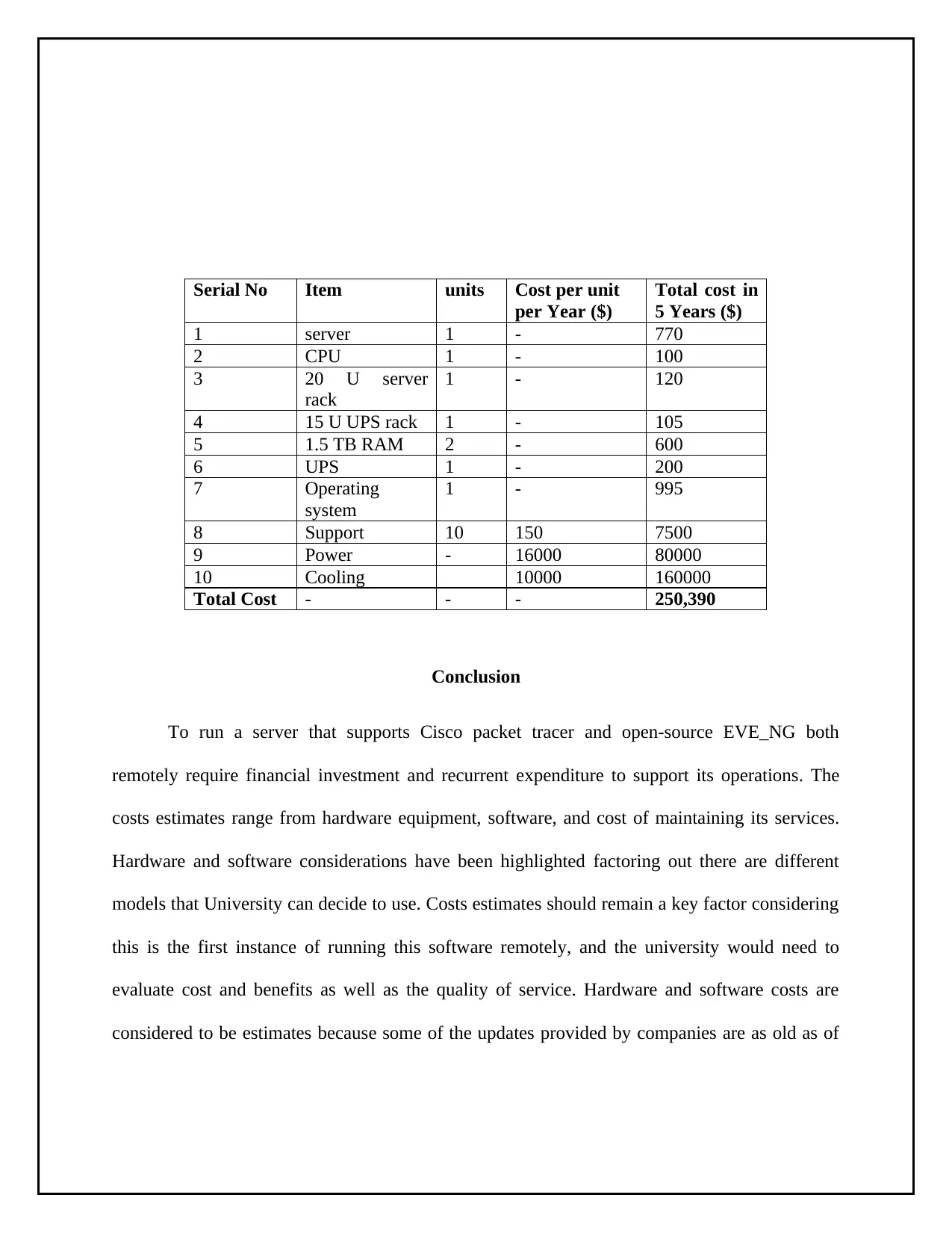
Serial No Item units Cost per unit
per Year ($)
Total cost in
5 Years ($)
1 server 1 - 770
2 CPU 1 - 100
3 20 U server
rack
1 - 120
4 15 U UPS rack 1 - 105
5 1.5 TB RAM 2 - 600
6 UPS 1 - 200
7 Operating
system
1 - 995
8 Support 10 150 7500
9 Power - 16000 80000
10 Cooling 10000 160000
Total Cost - - - 250,390
Conclusion
To run a server that supports Cisco packet tracer and open-source EVE_NG both
remotely require financial investment and recurrent expenditure to support its operations. The
costs estimates range from hardware equipment, software, and cost of maintaining its services.
Hardware and software considerations have been highlighted factoring out there are different
models that University can decide to use. Costs estimates should remain a key factor considering
this is the first instance of running this software remotely, and the university would need to
evaluate cost and benefits as well as the quality of service. Hardware and software costs are
considered to be estimates because some of the updates provided by companies are as old as of
per Year ($)
Total cost in
5 Years ($)
1 server 1 - 770
2 CPU 1 - 100
3 20 U server
rack
1 - 120
4 15 U UPS rack 1 - 105
5 1.5 TB RAM 2 - 600
6 UPS 1 - 200
7 Operating
system
1 - 995
8 Support 10 150 7500
9 Power - 16000 80000
10 Cooling 10000 160000
Total Cost - - - 250,390
Conclusion
To run a server that supports Cisco packet tracer and open-source EVE_NG both
remotely require financial investment and recurrent expenditure to support its operations. The
costs estimates range from hardware equipment, software, and cost of maintaining its services.
Hardware and software considerations have been highlighted factoring out there are different
models that University can decide to use. Costs estimates should remain a key factor considering
this is the first instance of running this software remotely, and the university would need to
evaluate cost and benefits as well as the quality of service. Hardware and software costs are
considered to be estimates because some of the updates provided by companies are as old as of
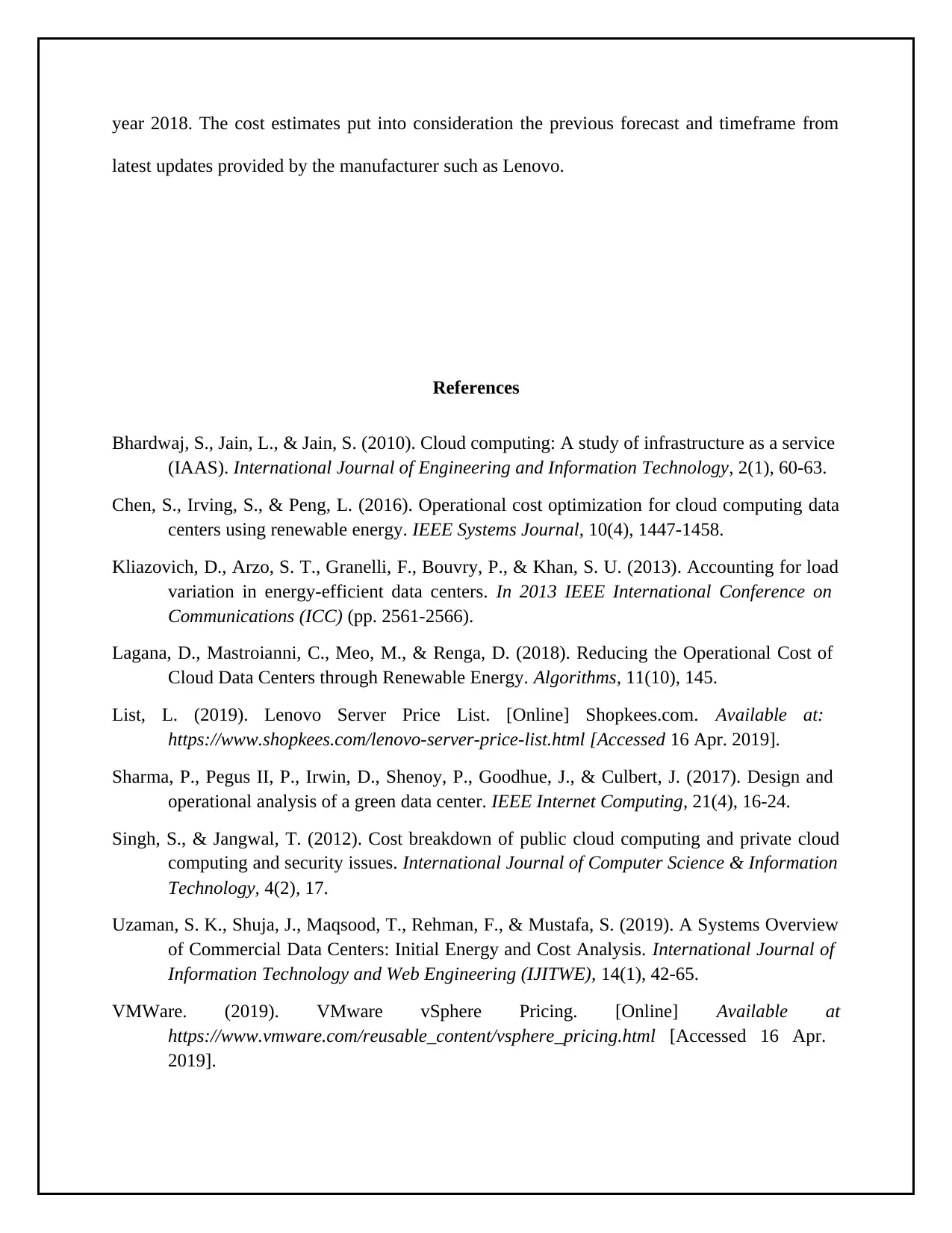
year 2018. The cost estimates put into consideration the previous forecast and timeframe from
latest updates provided by the manufacturer such as Lenovo.
References
Bhardwaj, S., Jain, L., & Jain, S. (2010). Cloud computing: A study of infrastructure as a service
(IAAS). International Journal of Engineering and Information Technology, 2(1), 60-63.
Chen, S., Irving, S., & Peng, L. (2016). Operational cost optimization for cloud computing data
centers using renewable energy. IEEE Systems Journal, 10(4), 1447-1458.
Kliazovich, D., Arzo, S. T., Granelli, F., Bouvry, P., & Khan, S. U. (2013). Accounting for load
variation in energy-efficient data centers. In 2013 IEEE International Conference on
Communications (ICC) (pp. 2561-2566).
Lagana, D., Mastroianni, C., Meo, M., & Renga, D. (2018). Reducing the Operational Cost of
Cloud Data Centers through Renewable Energy. Algorithms, 11(10), 145.
List, L. (2019). Lenovo Server Price List. [Online] Shopkees.com. Available at:
https://www.shopkees.com/lenovo-server-price-list.html [Accessed 16 Apr. 2019].
Sharma, P., Pegus II, P., Irwin, D., Shenoy, P., Goodhue, J., & Culbert, J. (2017). Design and
operational analysis of a green data center. IEEE Internet Computing, 21(4), 16-24.
Singh, S., & Jangwal, T. (2012). Cost breakdown of public cloud computing and private cloud
computing and security issues. International Journal of Computer Science & Information
Technology, 4(2), 17.
Uzaman, S. K., Shuja, J., Maqsood, T., Rehman, F., & Mustafa, S. (2019). A Systems Overview
of Commercial Data Centers: Initial Energy and Cost Analysis. International Journal of
Information Technology and Web Engineering (IJITWE), 14(1), 42-65.
VMWare. (2019). VMware vSphere Pricing. [Online] Available at
https://www.vmware.com/reusable_content/vsphere_pricing.html [Accessed 16 Apr.
2019].
latest updates provided by the manufacturer such as Lenovo.
References
Bhardwaj, S., Jain, L., & Jain, S. (2010). Cloud computing: A study of infrastructure as a service
(IAAS). International Journal of Engineering and Information Technology, 2(1), 60-63.
Chen, S., Irving, S., & Peng, L. (2016). Operational cost optimization for cloud computing data
centers using renewable energy. IEEE Systems Journal, 10(4), 1447-1458.
Kliazovich, D., Arzo, S. T., Granelli, F., Bouvry, P., & Khan, S. U. (2013). Accounting for load
variation in energy-efficient data centers. In 2013 IEEE International Conference on
Communications (ICC) (pp. 2561-2566).
Lagana, D., Mastroianni, C., Meo, M., & Renga, D. (2018). Reducing the Operational Cost of
Cloud Data Centers through Renewable Energy. Algorithms, 11(10), 145.
List, L. (2019). Lenovo Server Price List. [Online] Shopkees.com. Available at:
https://www.shopkees.com/lenovo-server-price-list.html [Accessed 16 Apr. 2019].
Sharma, P., Pegus II, P., Irwin, D., Shenoy, P., Goodhue, J., & Culbert, J. (2017). Design and
operational analysis of a green data center. IEEE Internet Computing, 21(4), 16-24.
Singh, S., & Jangwal, T. (2012). Cost breakdown of public cloud computing and private cloud
computing and security issues. International Journal of Computer Science & Information
Technology, 4(2), 17.
Uzaman, S. K., Shuja, J., Maqsood, T., Rehman, F., & Mustafa, S. (2019). A Systems Overview
of Commercial Data Centers: Initial Energy and Cost Analysis. International Journal of
Information Technology and Web Engineering (IJITWE), 14(1), 42-65.
VMWare. (2019). VMware vSphere Pricing. [Online] Available at
https://www.vmware.com/reusable_content/vsphere_pricing.html [Accessed 16 Apr.
2019].
⊘ This is a preview!⊘
Do you want full access?
Subscribe today to unlock all pages.

Trusted by 1+ million students worldwide
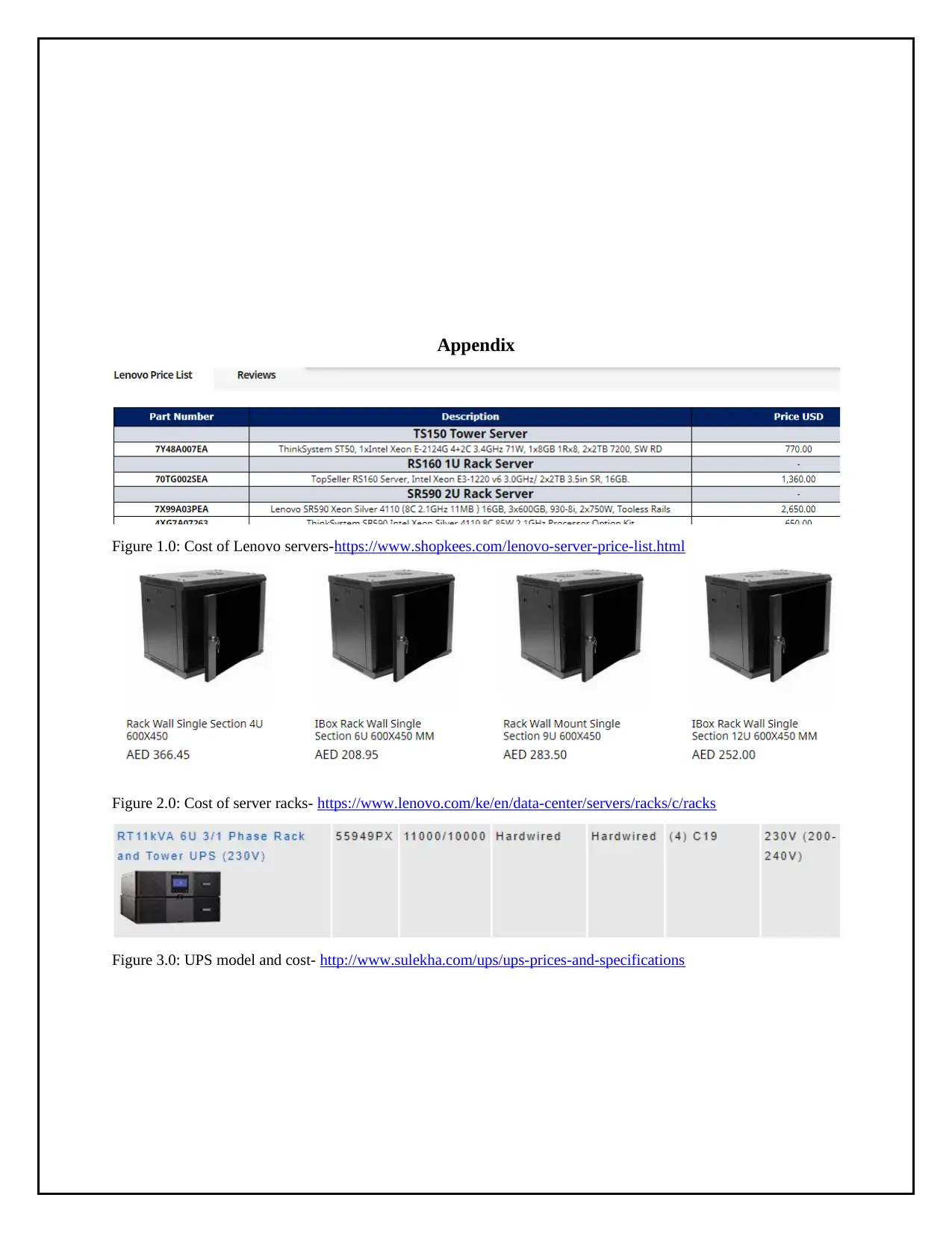
Appendix
Figure 1.0: Cost of Lenovo servers-https://www.shopkees.com/lenovo-server-price-list.html
Figure 2.0: Cost of server racks- https://www.lenovo.com/ke/en/data-center/servers/racks/c/racks
Figure 3.0: UPS model and cost- http://www.sulekha.com/ups/ups-prices-and-specifications
Figure 1.0: Cost of Lenovo servers-https://www.shopkees.com/lenovo-server-price-list.html
Figure 2.0: Cost of server racks- https://www.lenovo.com/ke/en/data-center/servers/racks/c/racks
Figure 3.0: UPS model and cost- http://www.sulekha.com/ups/ups-prices-and-specifications
Paraphrase This Document
Need a fresh take? Get an instant paraphrase of this document with our AI Paraphraser
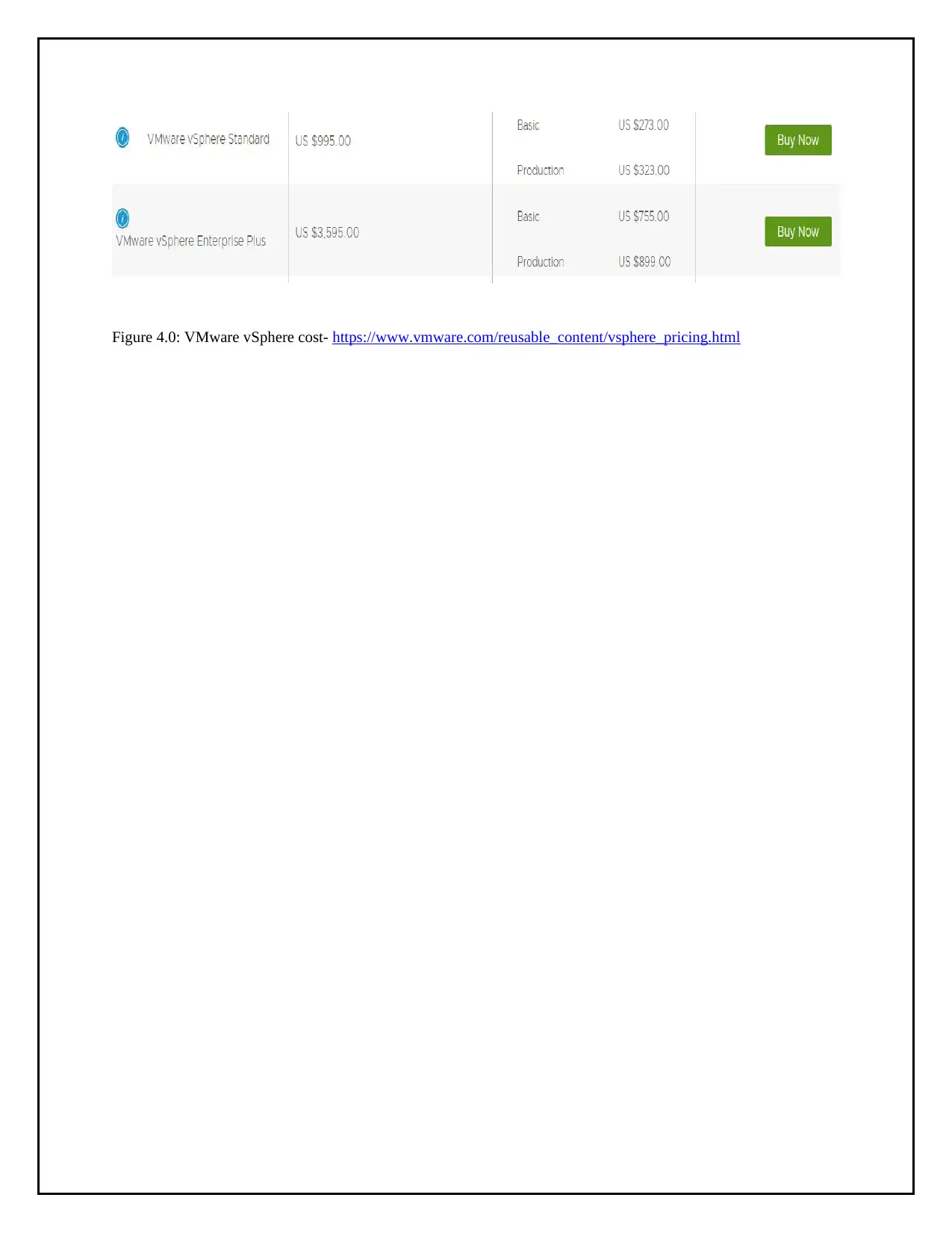
Figure 4.0: VMware vSphere cost- https://www.vmware.com/reusable_content/vsphere_pricing.html
1 out of 8
Related Documents
Your All-in-One AI-Powered Toolkit for Academic Success.
+13062052269
info@desklib.com
Available 24*7 on WhatsApp / Email
![[object Object]](/_next/static/media/star-bottom.7253800d.svg)
Unlock your academic potential
Copyright © 2020–2025 A2Z Services. All Rights Reserved. Developed and managed by ZUCOL.





